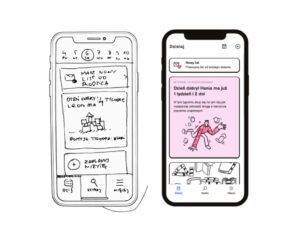The effective work of developers requires effectively organized cooperation with clients. That is why the work of people responsible for consulting and analysis, the intermediaries between ideas and conceptions, business, and the technical side, is so important.
For this reason, we have decided to share more information about how this cooperation is organized in Espeo Blockchain in the form of an interview with our Solutions Consultant Agnieszka Hołownia-Niedzielska.
Watch the interview here (or scroll down and read it):
During the interview, Agnieszka will tell you about:
- our relationship with the cryptocurrencies and NFT, and why she won’t give you any advice on which cryptocurrency you should buy,
- our technology stack (i.e. React, ReactNative, Java, PHP, Node.JS, Solidity, GoLang)
- who our clients are, in what industries they are present, what are they doing, and how we help them,
- the developer’s perspective of working in Espeo Blockchain (well-structured specification, SCRUM, etc.),
- what makes working in Espeo Blockchain unique,
- how to join our team (there are more possibilities than simply applying to us),
- what is the next big thing for the blockchain world?
Agnieszka, what are you precisely responsible for in Espeo Blockchain?
I work with the client and developers from the beginning, almost from the first contact with the customer during the sales phase, then when we prepare the estimation, through the kick-off phase and the entire implementation process. I’m in charge of gathering business and partially system requirements.
Together with the clients, we work starting with their vision, an exceptionally visionary idea for the product, to the phase of the actual outcome. The great moment is being around new technologies and sometimes putting out fires.
What relationship does Espeo Blockchain have with cryptocurrencies?
I won’t advise you which cryptocurrencies to buy and which NFT to invest in. These are certainly not the areas in which we are interested.
However, you must remember that blockchain is primarily a technology, so both crypto and NFT are within this area. We won’t tell you where to invest, but of course, we do projects that are related, for example, to crypto exchanges. We can build an exchange system that will help traders settle their tax obligations. And when it comes to NFT projects, that’s where we get a lot of inquiries.
We focus on mature projects where the vision is a niche, well thought out, and valuable. Of course, these projects must have a legal framework and an organizational background.
Please tell me more about NFT. From what I gather, they tend to be smaller projects?
That’s true, but we also work with large organizations, with enterprise-class blockchain. It’s about large international organizations, global ones that have many brands with multiple international branches. These mature projects affect the work, not tens but at least hundreds or even thousands of people.
Could you give a specific example of such a solution?
We’re a Certified Hyperledger Fabric Service Provider, creating solutions based on enterprise-class blockchain. For example, in large companies with 200 branches, each one of these branches can be a completely separate entity, both from the legal and organizational points of view. And now let’s imagine that in such a large organization, there is just one issue, we have done several such projects, and there is an issue related to referrals.
An international client came to one of the branches, but they also get services from many other branches, there are cash flows included, some commissions, someone is responsible for this customer on an international scale, well, and this information, typically is just sent by a million emails, Excel files, discussions, which version is accurate, well, and this is where blockchain comes in.
A system on which we can build a whole solution that will automate this work and allow each of these participants to be an equal member of the network. Each one of these branches has a full copy of the data. They have the same write and read permissions. If they do anything on this network, every other participant will be fully aware of such action. It’s all about transparency, and blockchain is an excellent solution in this context.
As a bonus feature, we have the fact that earlier, you had to check something in 5 different systems and paste it into Excel, but from now on, it can be done by a system that will automatically update the status.
What does it look like from the developers’ perspective?
From the developers’ perspective, my job is to build the bridge between the technical and the customer side. The idea is that our developers always work with a well-structured specification.
I start working with the client from the very beginning, from the moment when it is necessary to determine what is to be done. Next, at the moment when we already know what is truly needed, I direct my steps to the Delivery Manager and the estimation team.
So all these discussions at the next stage happen within my role. It is also crucial that the estimation team includes the development team so that you can extend your set of skills if you are a developer who wants to be involved when we’re planning solutions and building them.
And, of course, the result is an offer. The customer accepts it. Then it is the developers and me again. At this stage, we start creating a solution together. We work in a SCRUM way and talk with the customer daily as we want to keep constant contact with them.
Naturally, something may change during the development phase of a project. If it changes, it’s my role to clarify and define it.
Nobody likes it when requirements float, meaning they change during the course of the project. And it is the worst when the requirements float, but the deadlines do not. And that’s where my role is, along with the Delivery Manager, to make sure that if we’re changing something, we have clarity of priorities. As we achieve it, even if we change something or add something new to the project, it always affects the deadlines, and that’s what developers appreciate.
That is one side, and what does it look like from the clients’ perspective?
The client meets the Solutions Consultant right away when we go into a solution-specific discussion. I ask multiple questions, gather the needs, analyze documents, and suggest possible solutions. What happens then, is the backstage putting all that information into structured files, analyzing, and estimating.
The next touchpoint with the client after our internal work is an offer presented with a precise description of what is to be done and which solutions we advise and why, both in the area of technology and tools.
What is essential for the client is a detailed list of items and assumptions, so if we need to change the project scope or timeline, that is a material to do that transparently and efficiently.
So you’re the connector between the developer and the client, you make the developers work as smoothly as possible, and at the same time, the developers are as happy as possible.
Exactly. It’s all about making it easy to communicate so that one way or another, the client, and the developer, can work on the specification, and the client works in a way that feels natural to them.
We could say your role is primarily about ensuring developers know what to do.
Not mostly. My role is as necessary from the client’s and developers’ points of view. I focus on bringing value to the project and clarifying requirements. That is a key to building what is needed from the client and, most importantly, the end-users perspective. No one wants the memes about the difference between reality vs. expectations or delivery vs. order to become true when their money is at stake. And solid technical and business analysis is crucial so that wouldn’t happen.
Please, tell me more about the technology stack that we work with and that our developers work with.
We work with mature technologies. There are lots of them: TypeScript, JavaScript, there are frontend technologies too, React, ReactNative, of course, the backend – Java, PHP, Node.JS, and let’s not forget about blockchain, if we talk about these technologies related to Ethereum, it’s Solidity language, when we speak about Hyperledger Fabric it’s GoLang or Node.js, there’s a lot, there’s a lot to choose from.
Please tell us what industries we work with. Are there as many of them as the technologies we use, or are there fewer?
Yes, there are just as many. I mean, first of all, we were talking about enterprise companies, consulting companies, fintech, financial institutions, the healthcare industry, edutech industry. Recently there have been a few gaming projects, so there is a lot to choose from here as well. You can specialize in both technology and domain.
And how is the typical team built? What are the responsibilities within the team?
Mostly it depends on the project, but we could describe a typical team as the team responsible for building and delivering the entire solution.
In this prevalent case, we have a core team: frontend and backend developers supported by quality assurance experts. These specialists create the user interface, backend logic, and integrations and test solutions manually and automatically.
Other roles are also engaged according to the project needs: Solution Consultant. We are talking about this role a lot today. Delivery Manager: work and communication coordinator, taking care of administrative tasks and monitoring progress. We have DevOps, setting up and configuring IT environments, and designers specializing in UX, who make sure we create not only elegant and beautiful apps but also intuitive processes within them. Lastly, let’s not forget blockchain developers, people specializing in building network solutions, smart contracts, and public or private blockchain networks.
What do you think makes Espeo Blockchain unique? Please tell me, what does it look like for you at Espeo?
We create using technologies that are changing the world. We cooperate with international clients, small companies, and start-ups that have extraordinary ideas and want to change the reality we know, but also with mature enterprise-class clients, which we have also mentioned today.
However, what I personally value most is remote work. In Espeo Blockchain, it is not fiction, as it is genuinely available, and it does not mean that you are omitted from any possible benefits or various initiatives.
What job opportunities do we currently have at Espeo Blockchain?
Well, there are two paths to join us. Firstly, if you already have experience with blockchain, by all means, visit our website. You can go into our “we are hiring ” section and see what’s available.
The second path for those people who have less experience is the Blockchain Academy. This is quite a unique proposal. We are looking for people who already have experience in programming, most often, it is programming in some backend languages.
In this case, you could already know what you want from blockchain and what is the exact thing that you want to learn. You may also not know yet what you want from blockchain and look for your own path, and here we are for you too. We teach blockchain technology, help you grow as a blockchain developer, and just after you learn what you want to do, you can choose your own path.
Blockchain Academy is the kind of a place where we seek developers already with some programming experience but who are not yet familiar with blockchain technologies.
You previously said you wouldn’t tell me which crypto assets to buy, but as a final thought, would you share what the next big thing for the blockchain world is?
That I can tell. My personal opinion is that NFT will find its place in the art and investment world. There are projects with enormous potential. There are artists and brands to be discovered and collectors that would love to have their collections always with them.
For B2B blockchain adoption, the projects will continue evolving from smaller, disruptive apps to regular, commonly used solutions. The enterprise world will benefit most from private blockchains, not only opening for PoC projects but implementing full-scale solutions.




